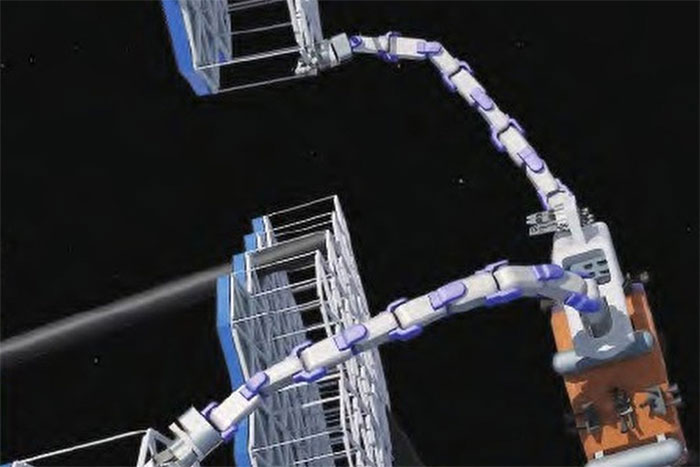With a solid body design consisting of detachable segments that operate as an independent robot, this machine can navigate even the tightest corners of space.
According to the South China Morning Post (SCMP), the Chinese research team behind the project has developed a solid-bodied robot with unprecedented strength, flexibility, and longevity for space exploration. This invention comes amid concerns about China’s potential to disrupt satellites of other nations.

Simulation of a robot arm extending in space. (Photo: Institute of Optics, Mechanics, and Physics, Changchun)
The new robot is 1.5 meters long, attached to a spacecraft, and consists of nine segments, each capable of generating a torque of 190 Newton-meters—double the power of a 1,200cc motorcycle. The joints between the segments can twist and rotate widely, allowing the robot to navigate complex environments and reach the tightest spaces of a space station or satellite that current astronauts or robot arms cannot access.
Theoretically, if the robot encounters any malfunction or segment failure, they can be easily replaced with new connectors, allowing the robot’s operational lifespan to extend indefinitely.
“Repairing satellites and spacecraft in complex space environments consumes significant manpower and materials.” The research team, led by Professor Xu Zhenbang from the Optical Space System Laboratory at the Institute of Optics, Mechanics, and Physics in Changchun, stated in a paper published in a robotics technology journal last month.
Professor Xu and his colleagues noted that the robots could coordinate with each other and function like tentacles to move or control a large object.
Last month, China’s Shijian 21 satellite successfully towed a defunct Beidou satellite to a higher orbit, designated as a graveyard for dead satellites. While details remain classified, the successful mission demonstrates that China possesses advanced robotic technology capable of tracking and controlling non-cooperative targets in space.
Many countries have expressed concerns that China could use similar technology to disable satellites of other nations. The U.S. military is particularly worried about China’s anti-satellite capabilities, especially regarding Shijian 17—a test probe equipped with a robotic arm that has conducted unusual activities since its launch into orbit in 2016.
Meanwhile, the Chinese government asserts that its space robotic technology is developed solely for peaceful purposes, such as building large-scale infrastructure to support spacecraft or satellites in orbit and removing space debris.
In a white paper released this month, the China National Space Administration announced plans to turn space debris cleanup into a profitable business within five years.
Previously, solid robots were used to inspect underwater optical cables and perform other tasks, but due to technical challenges, there have been no reports of their use in space until now.
In the machine developed by the Changchun Institute, each segment is an independent robot with its own motor, actuator, processor, and sensor.
According to researchers, each segment needs to be interconnected, coordinating all movements to complete tasks and requiring support from advanced artificial intelligence technology. Professor Xu mentioned that the team will further improve the robot before deploying it into space. Specifically, some components made from metal alloys will be upgraded to carbon fiber to reduce weight.
Professor Xu’s research team has tested this type of robot in simulated ground missions, including exploring uncharted territories. There, the robot identifies gaps, enters tight spaces, and adjusts the segments flexibly to avoid contact with obstacles while moving forward.
A scientist working in Beijing stated that the robot is powerful enough to crush a small satellite like “a python squeezing its prey.” However, this unnamed scientist suggested that the public disclosure of this robotic machine indicates that China does not plan to use it as a weapon.


















































